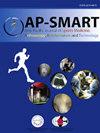骨骼成熟的青少年患者解剖双束前交叉韧带重建的临床结果:与单束手术的比较
IF 1.4
Q3 ORTHOPEDICS
Asia-Pacific Journal of Sport Medicine Arthroscopy Rehabilitation and Technology
Pub Date : 2025-06-04
DOI:10.1016/j.asmart.2025.04.006
引用次数: 0
摘要
本研究旨在比较骨骼成熟青少年双束(DB) ACL重建(ACLR)和单束(SB) ACLR的临床结果。方法对113例单侧前交叉韧带损伤的骨骼发育成熟的青少年,采用自体腘绳肌腱移植术行原发性前交叉韧带修复,随访至少2年。其中DB ACLR 82例(中位数16.0[四分位间距(IQR), 2.0]岁,男/女:21/61),SB ACLR 31例(17.0[2.0]岁,男/女:6/25)。在最终随访(3.6[1.9]年)时,获得IKDC主观膝关节形态(IKDC- skf)、Tegner活动量表、KT关节计胫骨前平移的侧侧向差(SSD)。同时评估残端枢轴移位率、移植物破裂率和对侧ACL损伤率。结果DB组残余枢轴偏移率显著低于SB组(12.0% vs 33.3%, P = 0.02)。DB组术后Tegner活动量表(7[2])显著高于SB组(4 [2],P = 0.002)。两组间IKDC-SKF (DB组96.6 [10.0],SB组97.7[9.0])和SSD胫骨前平移(DB组1.5 [2.0]mm, SB组2.0 [2.0]mm)差异无统计学意义。DB组7例(8.5%),SB组1例(3.3%)。DB组对侧前交叉韧带损伤4例(4.9%),SB组2例(6.5%)。两组间移植物断裂及对侧ACL损伤发生率无显著差异。结论DB ACLR的临床结果与SB ACLR相似,但DB ACLR的枢轴移位现象比SB ACLR得到更好的控制。因此,为了更好地恢复旋转膝关节的稳定性,推荐在骨骼成熟的青少年中使用DB ACLR。证据水平ii。本文章由计算机程序翻译,如有差异,请以英文原文为准。
Clinical outcomes following anatomic double-bundle ACL reconstruction in skeletally mature adolescent patients: Comparison to single-bundle procedure
Background
The present study was aimed to compare the clinical outcomes following double-bundle (DB) ACL reconstruction (ACLR) with the outcomes following single-bundle (SB) ACLR in skeletally mature teenagers.
Methods
A total of 113 skeletally mature teenagers with unilateral ACL injury, who underwent primary ACLR using hamstring autograft with minimum 2 years follow-up, were included. This included 82 DB ACLR (median 16.0 [interquartile range (IQR), 2.0] year-old, male/female: 21/61) and 31 SB ACLR (17.0 [2.0] year-old, male/female: 6/25). At the final follow-up (3.6 [1.9] years), IKDC Subjective Knee Form (IKDC-SKF), Tegner activity scale, the side-to-side difference (SSD) in anterior tibial translation using KT arthrometer were obtained. The rate of residual pivot-shift test, graft rupture rate and contralateral ACL injury rate were also assessed.
Results
The rate of residual pivot-shift test was significantly lower in DB group than SB group (12.0 % vs 33.3 %, P = 0.02). Postoperative Tegner activity scale was significantly greater in DB group (7 [2]) than SB group (4 [4], P = 0.002). No significant differences were observed between two groups in IKDC-SKF (96.6 [10.0] in DB group, 97.7 [9.0] in SB group) and SSD in anterior tibial translation (1.5 [2.0] mm in DB group, 2.0 [2.0] mm in SB group). Graft rupture occurred in seven patients in DB group (8.5 %), and one patient in SB group (3.3 %). Contralateral ACL injury occurred in four patients in DB group (4.9 %), and two patients in SB group (6.5 %). No significant differences were observed between two groups in graft rupture and the contralateral ACL injury rates.
Conclusion
Clinical outcomes following DB ACLR were similar to SB ACLR, but the pivot-shift phenomenon appeared to be better controlled in DB ACLR than SB ACLR. Thus, to better restore rotatory knee stability, DB ACLR may be recommended in the skeletally mature teenagers.
Level of evidence
III.
求助全文
通过发布文献求助,成功后即可免费获取论文全文。
去求助
来源期刊
CiteScore
3.80
自引率
0.00%
发文量
21
审稿时长
98 days
期刊介绍:
The Asia-Pacific Journal of Sports Medicine, Arthroscopy, Rehabilitation and Technology (AP-SMART) is the official peer-reviewed, open access journal of the Asia-Pacific Knee, Arthroscopy and Sports Medicine Society (APKASS) and the Japanese Orthopaedic Society of Knee, Arthroscopy and Sports Medicine (JOSKAS). It is published quarterly, in January, April, July and October, by Elsevier. The mission of AP-SMART is to inspire clinicians, practitioners, scientists and engineers to work towards a common goal to improve quality of life in the international community. The Journal publishes original research, reviews, editorials, perspectives, and letters to the Editor. Multidisciplinary research with collaboration amongst clinicians and scientists from different disciplines will be the trend in the coming decades. AP-SMART provides a platform for the exchange of new clinical and scientific information in the most precise and expeditious way to achieve timely dissemination of information and cross-fertilization of ideas.

 求助内容:
求助内容: 应助结果提醒方式:
应助结果提醒方式:


